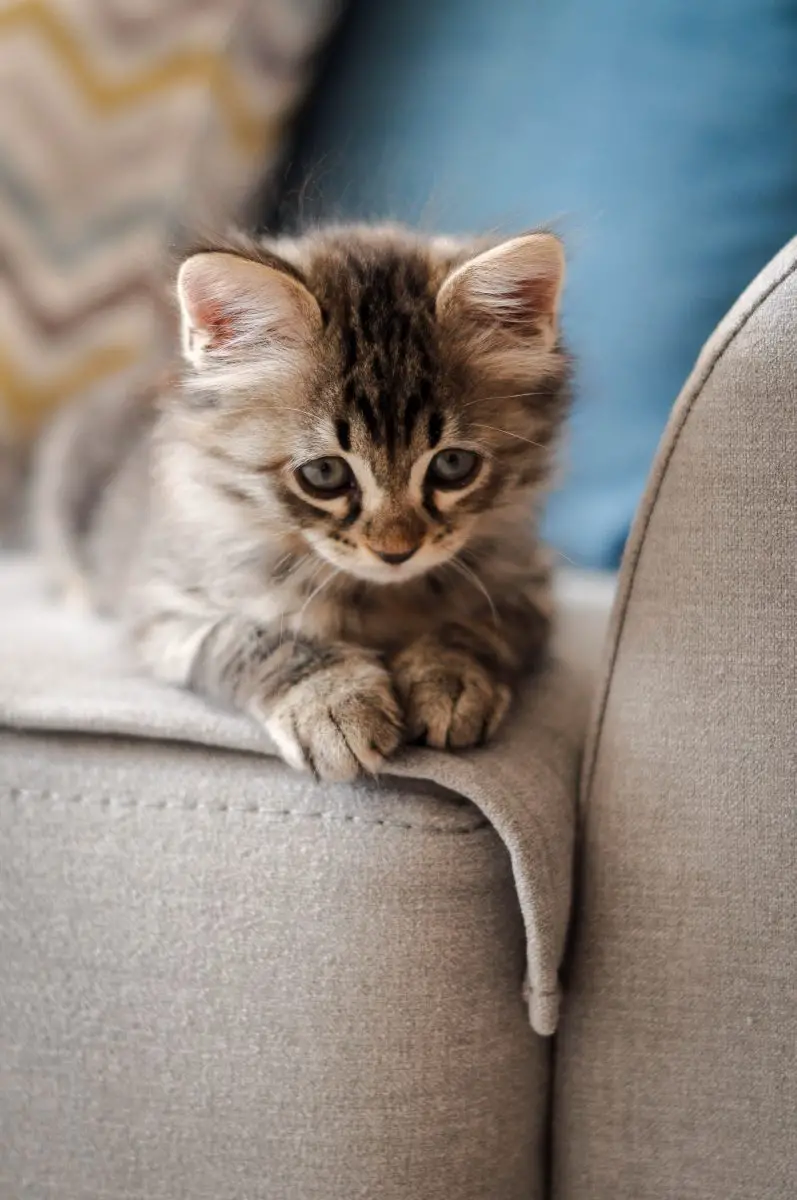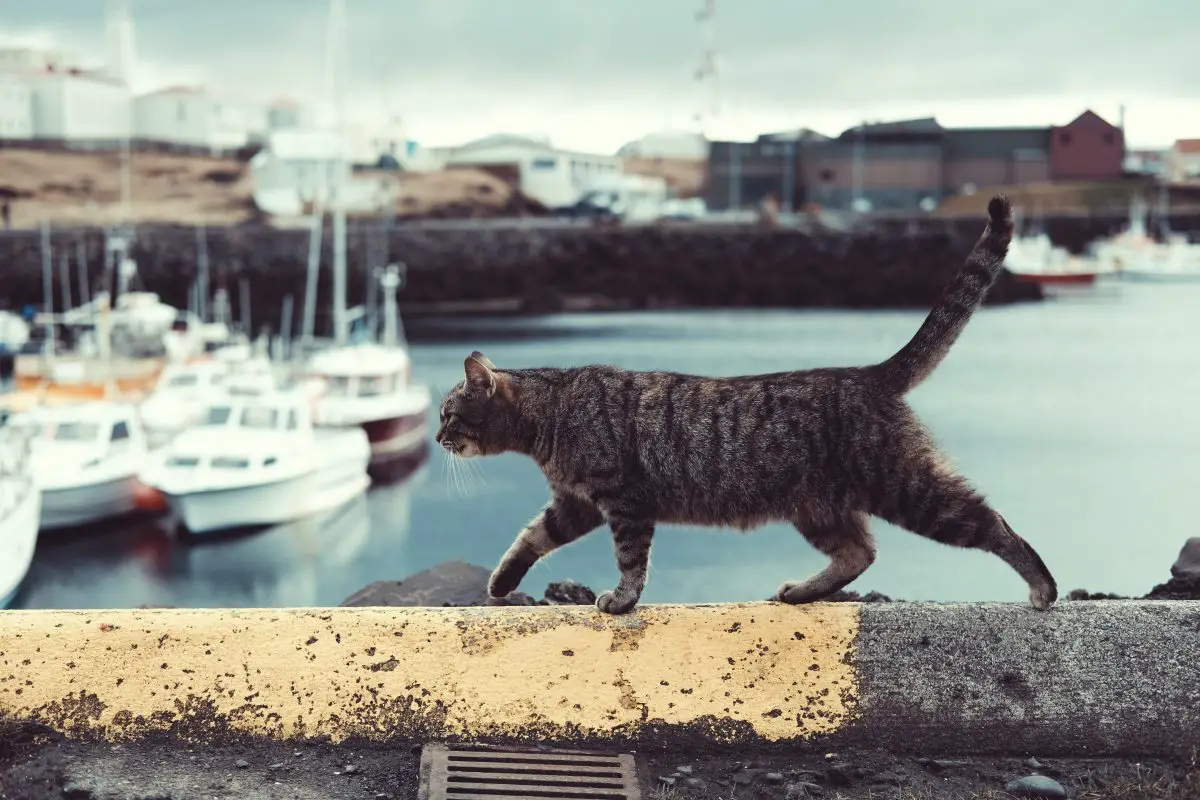Wenn Sie Katzen besitzen, wissen Sie bereits, dass sie zu den coolsten Tieren der Welt gehören. Katzen gelten neben Hunden als die beliebtesten domestizierten pelzigen Freunde und sind ausgezeichnete Begleiter. Aber sie sind auch rätselhafte kleine Serienmörder mit einer Vorliebe dafür, Pflanzen zu kauen. Kein Wunder, dass manche Leute glauben, dass Katzen gewählt domestiziert zu werden, weil sie Menschen als nützlich bei ihrem Streben nach weltweiter Vorherrschaft ansahen.
Ist das wahr? Ich kann es nicht mit Sicherheit sagen, aber wir haben einige lustige und interessante Fakten über Katzen, die Ihren Quizabend zum Thema Haustiere mit Sicherheit aufpeppen werden.
Inhaltsverzeichnis
- Süße Fakten über Katzen
- Erstaunliche Fakten über Katzen
- Katzen können nicht mit gesenktem Kopf klettern
- Katzen können bis zu 30 Meilen pro Stunde laufen
- Schildpatt- und Calico-Katzen sind fast immer weiblich
- Träumen Katzen von Katzenminzenschafen?
- Navigieren durch die Strahlen der Sonne
- Katzen haben mehr Knochen als Menschen
- Katzen schwitzen durch ihre Füße
- Lustige Fakten über das Verhalten von Katzen
- Interessante Fakten über Katzen, damit Kinder ihre Freunde beeindrucken können
- Alle Fakten über Katzen, die Sie jemals brauchen werden
Süße Fakten über Katzen
Es lässt sich nicht leugnen, dass Katzen bezaubernd sind. Obwohl sie vielleicht nicht so albern und liebenswert sind wie Hunde, haben Katzen Eigenschaften und Stimmungen, die Menschen verrückt machen. Wer möchte nicht die Zehenbohnen berühren?
Hier sind einige süße Fakten über Katzen, die Sie unbedingt wissen sollten:
- Die meisten Katzen haben keine Wimpern. Ja, sie haben Fell um ihre Augenlider, das Wimpern ähnelt, aber sie brauchen keine Wimpern. Es gibt noch etwas anderes, das die Aufgabe der Wimpern bei Katzen übernimmt – das dritte Augenlid, auch bekannt als Nickhaut.
- Katzen können nicht direkt unter die Nase sehen. Darum kann man ihnen kein Leckerli hinlegen und erwarten, dass sie es sofort finden. Sie können jedoch auf das zeigen, was die Katze sehen soll, und Ihre Katze wird der Geste mit Sicherheit folgen.
- Eine Gruppe von Katzen ist als Wolke bekannt.
- Da ist ein Die hebräische Legende besagt, dass Gott Katzen erschaffen hat, als Noah Hilfe brauchte, um seine Lebensmittelvorräte vor Ratten auf der Arche zu schützen. Ein Löwe nieste, und ein Katzenpaar kam heraus!
- Katzen können verschiedene Stimmen erkennen. Also ja, sie ignorieren dich, wenn du ihren Namen rufst.
- Katzen haben auch ein selektives Gehör und wählen nur das aus, von dem sie wissen, dass es nützlich ist. Hunde haben kein selektives Gehör, falls Sie sich das fragen.
- Jede Katze hat einen einzigartigen „Abdruck“ auf ihrer Nase, der den menschlichen Fingerabdrücken ähnelt. Wie süß.
- Entgegen der landläufigen Meinung brauchen Katzen keine Milch. Faszinierenderweise haben die meisten erwachsenen Katzen eine Laktoseintoleranz und können damit nicht umgehen. Dies liegt daran, dass Katzen kurz nach dem Absetzen die Produktion von Laktase einstellen, dem Enzym, das zum Abbau von Laktose benötigt wird.

Erstaunliche Fakten über Katzen
Nachdem Sie sich nun mit Fakten über niedliche Katzen vertraut gemacht haben, ist es an der Zeit, sich mit den Fakten zu befassen, die wirklich erstaunlich sind.
Katzen können nicht mit gesenktem Kopf klettern
Ist Ihnen schon einmal aufgefallen, dass Katzen ohne Zögern unglaublich hohe Bäume erklimmen können? Doch als sie auf den Boden zurückkehren, flippen sie aus? Der Grund, warum so viele Feuerwehren zur Rettung von in Bäumen festsitzenden Katzen eingesetzt werden, liegt darin, dass Katzen nicht mit nach unten gerichtetem Kopf klettern können.
Einer der Gründe dafür sind ihre Krallen. Beim Klettern verhaken sich ihre Krallen in den Baum oder Telefonmast und helfen ihnen, sich nach oben zu treiben. Ein Abstieg bringt nicht den gleichen Vorteil. Bleiben Katzen also wirklich in Bäumen stecken, obwohl sie meisterhafte Kletterer sind? Ja.
Katzen können bis zu 30 Meilen pro Stunde laufen
Sicher, Katzen scheinen faul zu sein, wenn sie sich auf den Rücken rollen und in der Sonne faulenzen den ganzen Tag, aber das sind sie nicht. Wenn es um Geschwindigkeit geht, sind domestizierte Katzen schnell. Teilweise in kurzen Schüben Katzen können Geschwindigkeiten von 48 km/h erreichen. Vergleichen, Die Höchstgeschwindigkeit eines Geparden beträgt 74,56 mph (119 km/h) und Löwen erreichen eine Höchstgeschwindigkeit von etwa 50 mph (81 kmh). Wenn Sie den Größenunterschied berücksichtigen, sind diese 30 Meilen pro Stunde beeindruckend.
Wie erreichen kleine Hauskatzen eine solche Geschwindigkeit? Beim Laufen arbeiten die Vorder- und Hinterbeine im Einklang. Die Vorderbeine drücken, während die Hinterbeine ihren Körper starten, was ihnen die Möglichkeit gibt, um 3 Uhr morgens um das Haus zu rennen.
Schildpatt- und Calico-Katzen sind fast immer weiblich
Wenn Sie einen Kaliko- oder Schildpatt-Kater haben, sind diese äußerst selten. Nur eine von 3.000 Kattunkatzen ist männlich. Wie kommt es dazu? Es ist das X- und Y-Chromosom.
Ähnlich wie Menschen haben weibliche Katzen eine XX-Paarung, während männliche Katzen XY haben. Da weibliche Katzen nur das X-Chromosom passieren können, das der Fellfarbe entspricht, zeigen viele weibliche Katzen am Ende die Farbe von Mutter und Vater sowie weißes Fell. Kater bekommen die Fellfarbe nur von ihrer Mutter.
Ebenso sind die meisten Ingwerkatzen männlich!
Träumen Katzen von Katzenminzenschafen?
Katzen und Menschen haben einiges gemeinsam, darunter auch den REM-Schlaf. Während der Phase der schnellen Augenbewegung kommt es zum Träumen. Katzen träumen vielleicht nicht davon, gegen Drachen zu kämpfen oder nackt zur Schule zu gehen, aber sie erleichtern ihnen den Alltag. Möglicherweise bemerken Sie, dass Ihre Katze ihre Pfoten bewegt oder zuckt. Manche schlafen sogar, obwohl das selten vorkommt. Am häufigsten träumt eine Katze davon, ein gutes Essen noch einmal zu erleben oder mit Spielzeug zu spielen.
Navigieren durch die Strahlen der Sonne
Haben Sie sich jemals gefragt, wie eine verlorene Katze problemlos den Weg zurück zu Ihrer Haustür finden kann? Viele, viele Jahre lang war dies ein Rätsel. Wissenschaftler haben herausgefunden, dass Katzen ein gutes Gedächtnis dafür haben, wo sie leben und reisen. Sie haben Mindmaps der Routen, die sie nehmen, sowie Hinweise, die ihnen helfen, sich zurechtzufinden, wenn sie unsicher sind, wohin sie wollen. Katzen achten auch auf den Stand der Sonne am Himmel und nutzen ihn als Orientierungshilfe.
Clever!
Katzen haben mehr Knochen als Menschen
Menschen mögen Katzen überragen, aber das bedeutet nicht, dass unsere Skelette so komplex sind. Katzen haben 250 Knochen während Menschen nur 206 haben. Die meisten zusätzlichen Knochen befinden sich im Schwanz, was einer Katze zusätzliche Mobilität verleiht. Tatsächlich hat allein der Schwanz zwischen 19 und 23 Wirbel, was 10% aller Knochen im Körper einer Katze ausmacht.
Katzen schwitzen durch ihre Füße
Einige der ersten Katzen, die den Planeten betraten, stammten aus Wüstenregionen. Da sie auf der Suche nach Nahrung durch trockene Regionen wanderten, haben sie sich entwickelt, um mit warmen Temperaturen zurechtzukommen. Viele Rassen sind nicht so geschickt im Umgang mit Hitze wie ihre Vorfahren, aber ein einzigartiges evolutionäres Merkmal bleibt bestehen: das Schwitzen durch die Pfoten.
Wenn eine Katze überhitzt ist, hechelt sie und schwitzt zwischen den Zehen. Möglicherweise bemerken Sie sogar eine Spur verschwitzter Pfotenabdrücke auf dem Küchenboden. Allerdings haben die meisten Katzen so kleine Füße, dass das Ausschwitzen der Pfoten nicht immer hilfreich ist und sie sich deshalb auch übermäßig ablecken, um sich abzukühlen.

Lustige Fakten über das Verhalten von Katzen
Nachdem Sie einige Fakten erfahren haben, die zeigen, wie unglaublich eine Katze ist, ist es an der Zeit, sich auf ihr Verhalten zu konzentrieren. Katzen sind in vielerlei Hinsicht das genaue Gegenteil von Hunden. Sie sind distanziert, unabhängig und neugierig bis zur Beharrlichkeit. Es gibt aber auch viele Katzen, die hundeähnliche Eigenschaften an den Tag legen, wie zum Beispiel mit ihren menschlichen Begleitern Spaziergänge oder Wanderungen unternehmen, Spielzeug holen und ihre Menschen vor Gefahren schützen.
Hier sind weitere lustige Fakten über das Verhalten von Katzen, die Sie vielleicht noch nicht kennen:
Katzen schlafen bis zu 18 Stunden am Tag
Katzen gehören zu den produktivsten Schläfern der Welt. Ein neugeborenes Kätzchen schläft fast 24 Stunden. Wenn Katzen älter werden, brauchen sie weniger Schlaf, aber die meisten schlafen im Durchschnitt etwa 18 Stunden am Tag. Um es so auszudrücken: Wenn Sie eine 9-jährige Katze besitzen, ist sie nur 3 Jahre ihres Lebens wach.
Das Herumlaufen und Beutejagen verbraucht in der Wildnis viel Energie. Schlaf hilft ihnen, Energie für die Jagd zu sparen. Das Gleiche gilt nicht für Hauskatzen, weshalb einige von ihnen Gewichtsprobleme haben!
Miauen ist nur Menschen vorbehalten
Hier ist eine lustige Tatsache über das Verhalten von Katzen: Miauen kommt zwischen Katzen nicht vor. Wenn eine Katze miaut, ruft sie nach Menschen.
Es wird angenommen, dass Katzen als Kätzchen miauen, um mit ihren Müttern zu kommunizieren. Wenn sie älter werden, beginnen sie möglicherweise, ihre Menschen als ihre Mütter zu betrachten, während sie andere Formen der Lautäußerung ihren Katzenfreunden vorbehalten.
Erwachsene Katzen reden miteinander über ihren Schwanz, ihr Gesicht und ihren Geruch. Menschen hingegen bekommen eine ganze Reihe von Lautäußerungen zu hören, die auf alles Mögliche hinweisen, von Begrüßungen bis hin zu „Runter deinen Hintern, ich habe Hunger!“
Toilettenmanieren
Katzen sind sehr reinliche Geschöpfe und mögen es, gepflegt auszusehen. Dies gilt für die Katzentoilette. Oft decken Katzen ihr Geschäft mit sauberem Streu ab. Es wird angenommen, dass dies das Verhalten des Lebens in freier Wildbahn widerspiegelt, wenn das Abdecken ihres Urins und Kots ihren Geruch vor Raubtieren verbirgt. Was bedeutet es also, wenn Ihre Katze ihre Haufen unbedeckt lässt?
Wenn Ihre Katze ihren Kot nicht bedeckt, ist das ein Zeichen dafür, dass sie keine Angst vor Ihnen hat.
Kitty-Kommunikation
Eine Katze spricht nicht nur durch Miauen mit Ihnen. Wenn beispielsweise eine Katze mit ihrem Gesicht an Ihnen reibt, bedeutet das, dass sie Sie als ihr Revier markiert. Um Nase und Wangen herum befinden sich Duftdrüsen, die ihren Duft hinterlassen.
Darüber hinaus gibt es Schwanzformen und Wedeln, langsames Blinzeln, Kneten oder „Kekse backen“. Der Hintern in deinem Gesicht, den du so sehr hasst? Es ist ein Zeichen der Freundschaft. Ein weiteres Signal dafür, dass Ihre Katze Sie als Freund betrachtet, ist, wenn sie ihren Schwanz über Sie legt.
Hier sind einige weitere verhaltensbezogene Fakten über Katzen:
- Wenn Katzen gelangweilt sind, greifen sie Ihre Knöchel an. Wenn ihre Katzen nicht draußen sind, ist das kein Zeichen von Aggression, sondern von Verspieltheit.
- Vibriert der Schwanz Ihrer Katze, wenn sie etwas sieht? Es ist seltsam zu sehen, aber es bedeutet, dass sie sich freuen, dich zu sehen.
- Katzen stehlen Gegenstände von ihren Besitzern und anderen, weil es sie an die Jagd erinnert.
- Wenn Sie das nächste Mal zwei Katzen beim Kämpfen oder Spielen beobachten, achten Sie auf die Katze, die zischt. Eine zischende Katze zeigt keine Aggression, sondern Angst und bedeutet, dass sie sich äußerst verletzlich fühlt.
- Vermeiden Sie direkten Augenkontakt mit Ihren Katzen, da sie ein solches Verhalten einschüchternd finden. Dies unterscheidet sich von Hunden, die freundlich zu Ihnen sind; Hunde verwenden Augenkontakt, um zu kommunizieren.

Interessante Fakten über Katzen, damit Kinder ihre Freunde beeindrucken können
Unabhängig von ihrem Alter werden Kinder diese Fakten über ihre pelzigen Freunde lieben. Geben Sie diese Fakten am Esstisch oder auf dem Schulweg herum:
- Sir Isaac Newton, derselbe Wissenschaftler, der die Schwerkraft entdeckte, erfand die erste Katzentür.
- Der Gehörsinn einer Katze ist fünfmal größer als der eines Menschen.
- Katzen können ihre Ohren auch um volle 180 Grad drehen.
- Katzen können fünfmal höher springen als sie selbst groß sind.
- Das Schnurren einer normalen Katze liegt zwischen 25 und 150 Hz, was der Frequenz entspricht, mit der Knochen und Muskeln beginnen, sich selbst zu reparieren. Es wird angenommen, dass Schnurren eine Form der Selbstheilung und Selbstberuhigung ist.
- Der Rekordhalter für das lauteste Schnurren ist eine Katze namens Merlin aus Torquay, UK. Sein Schnurren erreicht 67,8 Dezibel, was mehr als das Doppelte des normalen Schnurrens von 25 dB ist.
- Hauskatzen teilen etwa 951 TP2T ihrer Genetik und ihres Verhaltens mit Tigern. Also ja, Sie haben einen kleinen Tiger in Ihrem Haus.
- Entwicklungstechnisch entspricht das erste Lebensjahr einer Katze den ersten 15 Lebensjahren eines Menschen. Mit 2 Jahren entspricht die Entwicklung einer Katze der eines 25-jährigen Menschen. Von da an entsprechen die Lebensjahre einer Katze etwa sieben Lebensjahren eines Menschen.
Alle Fakten über Katzen, die Sie jemals brauchen werden
Was sind einige verblüffende Fakten über Katzen? Gehen Sie die Liste bei Bedarf noch einmal durch, denn hier gibt es so viele interessante Fakten über Katzen. Da Sie jetzt etwas mehr über Katzen wissen, empfinden Sie möglicherweise eine neue Liebe und Wertschätzung für Ihren schnurrenden Begleiter. Wenn sie das nächste Mal miauen, denken Sie daran, dass es nur für Sie ist!
Erfahren Sie mehr über Ihren katzenartigen Kumpel in unserem Beitrag über katzenschwanz bedeutungen!




